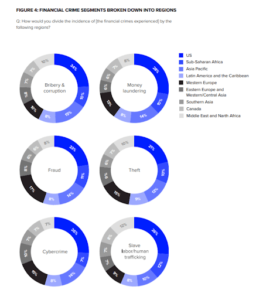Machine Learning for Fraud Detection – How It Works and Pressing Tasks It Solves
Fighting financial fraud is a never-ending battle. Technology is progressing and getting smarter along with scammers who are not shy about using innovation to get around innovative protection systems. And if we recall the case when fraudsters faked the voice of the head of the company using AI and gave the order to transfer a large amount of money, then it immediately becomes obvious that at the moment, the magic pill does not exist. Even the most progressive technologies have their own gaps.
Does this mean that financial companies should protect themselves from scammers in the old fashioned way? No, it doesn’t. At the moment, it is really impossible to guarantee 100 percent security, but it is possible to create and implement such systems of protection against financial fraud that will significantly lower the current figures.
Global Financial Fraud – Facts, Statistics, Infographics
- According to PVC research, 47% of companies have faced financial fraud in the past 24 months.
- Old and well-known cheating methods still work – fraudsters pretend to be police officers, bank employees or relatives of victims to force them to complete a transaction or give cash
- 72% of companies are convinced that avoiding risky and unreliable clients can protect against financial fraud.
- Most fraudulent attempts occur in the USA. The infographic below displays the percentage of financial crimes according to their type and geography.

How It Was Earlier – ML vs Rule-Based Detection
The above statistics are impressive. Moreover, this suggests that we can observe a very serious lack of opportunities to solve this problem. Machine learning, of course, is not a 100% cure for financial fraud, but the key features of this technology make it possible to prevent, detect and fight fraud more effectively. So why should financial institutions use machine learning? What’s the difference between old school methods like rule-based detection?
The essence of rule-based detection is clear from its name. In this case, the fraud detection system works according to clearly written scenarios, which do not allow deviating from a clear algorithm of potential fraudulent actions either to the right or to the left. In other words, as soon as the fraudster makes a non-typical move that was not known by the system, this action is recognized as legitimate. Machine learning gives you more power – let’s look at the table.
| Rule-based detection | ML fraud detection | |
| Speed | In most cases, fraud detection by this method occurs when the money is already stolen. That is, companies have to deal with the consequences. | In its turn, machine learning can perform a preventive function due to the possibility of predictive analytics, recognition of intentions, and the identification of atypical patterns of behavior. |
| Scale | On average, legacy systems know and recognize about 300 scenarios on average. At the time of the advent of the 301st, previously unknown scenario, the protective barrier will be broken. | Machine learning works with a huge amount of data. Moreover, it is impossible to calculate a clear number of scenarios due to the fact that the machine learning system works with hundreds or even thousands of variables. |
| Accuracy | It is possible to say the following – rule-based detection systems provide good accuracy only within the framework of these established rules. | While machine learning guarantees maximum accuracy, even when working with huge flows and volumes of data. |
| Efficiency | In the case of using an outdated approach, it is necessary to perform a large number of verification actions that adversely affect the user experience. | Due to greater accuracy, the system gains a new level of confidence in the legitimacy or illegality of behavior, eliminating the need for the user to prove his identity, the rightfulness of holding a card or completing a certain transaction. |
How Does It Work and Is It a Big Deal to Introduce ML to Your Business Processes?
The correct answer is yes and no at the same time. However, when you attract a reliable vendor, for example, the SPD Group to this process, the chances of creating a reliable system for detecting fraud increase at times.
Basically, you need to perform only three actions.
Input Data
After the data is collected, it is necessary to give the system the opportunity to work with it. At the moment when the data enters the system, the algorithms begin to analyze, make segmentation and classification.
Provide Training Sets
With classified data sets, it becomes possible to create training sets with which the system will learn to predict the likelihood of fraud. The simplest example of a training model is a model based on the main input parameter – the country in which the credit card was issued. By analyzing information about where the card was used today, as well as taking into account other data about the client, the system learns to recognize the legitimacy or illegality of transactions.
Build Models on Classification or Regression Approach
Based on primary knowledge, it is possible to build predictive models based on the classification or regression approach. A regression approach means building a model that will show the effect of an independent variable (the country in which the bank card was issued) on the dependent variable (the country in which the card was used today, yesterday, for the last time, and so on). The classification model is based on a clear algorithm – “If yes, then X”, “If not, then Y”
AI Fraud Detection From the Inside
So how does this system work from the inside out? There are four basic approaches.
- Supervised learning
This model is the most popular approach to ML in finance. To some extent, supervised learning is similar to the rule-based detection approach, only in this case we are dealing with a much larger number of input rules. The only limitation of this approach is that in this case, systems cannot go beyond the historical data with which they were trained.
- Unsupervised learning
This training model works with data in real-time and constantly updates its knowledge. This makes it possible to identify anomalies and atypical patterns of behavior, as well as make accurate forecasts based on them. This is the best model for combating financial fraud.
- Semi-supervised learning
As the name implies, this approach is on the border of the two previous ones. This is used when information labeling is either impossible or requires manual labor and is too expensive, but there is an assumption that the patterns found may be valuable.
- Reinforcement learning
Reinforcement learning is based on the fact that the system must constantly receive feedback regarding the conclusions it makes. In other words, this is a learning process with immersion in the environment – the system is constantly striving to find the ideal behavior in a given context.
Practical Side of the Issue
Fraud exists wherever there is money – however, we will look at the two main areas of machine learning application to combat it.
Fraud Detection in Banking
This question may deserve a separate article, but in its most basic form, ML in banking can cope with the following tasks:
- Determine whether a particular client can be involved in money laundering, terrorist financing, human trafficking
- Determine the risk of a loan by analyzing credit history, solvency and predicting intentions
- Detect anomalies, for example, an atypically large transaction amount, an unjustified excess of the credit limit on a card, a transaction from another country or from another device
- Identify the physical theft of a credit card through a face recognition system integrated into ATMs and installed at physical points of sale
- Prevent insurance fraud. This task also applies to the use of machine learning in the field of health care, as fraudsters in this industry are very well attracted by personal medical data that can be sold on the black market, used for further fraud (as is the case with insurance), or for blackmailing their victims.
Fraud Detection in E-Commerce
The most popular method of fraud in the field of electronic commerce is the theft of personal data, for example, through phishing sites, malicious software or hacking a password. After that, having the correct, but stolen data, scammers make transactions and purchases at their discretion. In this case, credit card fraud detection becomes possible by analyzing behavior and identifying anomalies.
In addition, data analysis also helps prevent promo code abuses. In this case, fraud is also recognized by analyzing behavior according to the IP address.
Moreover, modern systems are also able to recognize fake reviews. This is especially true for marketplaces, where buyers make a purchasing decision based on the opinions of other people. In this case, the system analyzes the writing style, content, and semantic load in order to distinguish true reviews from falsified ones.
Conclusion
Machine learning and fraud are pretty strong rivals. And it’s hard to say who wins at the moment. However, in any case, this is a worthy innovative idea to implement it in financial processes to increase security and customer loyalty.
internet security – DepositPhotos


